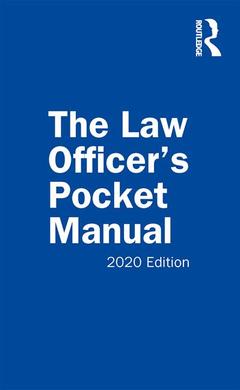Description
The Law Officer's Pocket Manual
2020 Edition
Authors: Miles Jr. John G., Richardson David B., Scudellari Anthony E.
Language: English
Subjects for The Law Officer's Pocket Manual:
Keywords
Eastern Time; Police; Crack Cocaine; Law enforcement; Good Faith Exception; Police Officer; Miranda Rules; US Constitution; Fourth Amendment’s Exclusionary Rule; Supreme Court; Circuit Court; Arrest; Custodial Interrogation; Patrol; Fourth Amendment; Stop and frisk; Miranda Warnings; Miranda; Canine Sniffs; U.S; Supreme Court rulings; Search Incident; Warrantless Search; criminal justice; Aid Virus; constitutional law issues; Suspect’s Reasonable Expectation; Motor Vehicle Stop; Mild Cerebral Palsy; Investigative Detention; Terry Stop; Warnings Requirement; Search Warrant; Automobile Exception; Gps Tracking Device; Interrogation Rights; Reasonable Suspicion; Criminal Justice Practitioners
Approximative price 40.18 €
In Print (Delivery period: 14 days).
Add to cart· Paperback
Description
/li>Contents
/li>Readership
/li>Biography
/li>
The Law Officer?s Pocket Manual is a handy, pocket-sized, spiral-bound manual that highlights basic legal rules for quick reference and offers examples showing how those rules are applied. The manual provides concise guidance based on U.S. Supreme Court rulings on constitutional law issues and other legal developments, covering arrest, search, surveillance, and other routine as well as sensitive areas of law enforcement. It includes more than 100 examples drawn from leading cases to provide guidance on how to act in a wide variety of situations.
The 2020 edition is completely updated to reflect recent court decisions. This book helps you keep track of everything in a readable and easy-to-carry format. Some of the most important case rulings from the past 12 months include:
- The U.S. Supreme Court ruled that probable cause for an arrest precludes a later First Amendment retaliatory arrest claim.
- The U.S. Supreme Court determined that the exigent circumstances doctrine to the Fourth Amendment will generally allow for a blood draw from an unconscious motorist to be performed without a warrant.
- The Eleventh Circuit ruled that seizing items, such as a mobile phone, from bystanders violates clearly established law and subjects the officer to a civil rights lawsuit.
- The Ninth Circuit ruled that the seizure of a mobile phone without a warrant following a high-speed chase was justified as an inventory search under the Fourth Amendment.
- The Second Circuit dove into the circuit split on rental car searches, deciding that an unlicensed driver not in lawful possession of the vehicle cannot challenge the search.
- The Seventh Circuit explained that the exclusionary rule does not apply to an illegal entry if there is overwhelming evidence of probable cause and a search warrant was planned before entry.
- The Second Circuit reaffirmed the principle that prolonging a traffic stop is not unconstitutional if the reason is supported by reasonable suspicion.
Annually updated since 1972, The Law Enforcement Pocket Manual, provides police officers, criminal justice practitioners, and students with historical and social context for their role in criminal justice and the guidelines that should be followed in day-to-day policing activities.
Routledge offers tiered discounts on bulk orders of 5 or more copies: For more information, please visit: https://www.routledge.com/collections/16268
I. Purpose and Use of This Manual; II. The Police-Citizen Encounter; A. Police Activities That Require No Evidence of Wrongdoing; B. Investigative Detention; C. Qualified Immunity; III. Identifications; A. In-Person Identifications; B. Photograph Identification; IV. Arrest; A. When an Arrest Takes Place; B. What You Need to Arrest—Probable Cause; C. Misdemeanor Arrests; D. Use of Force to Make an Arrest; E. When You Should Get an Arrest Warrant; F. When You Don’t Need an Arrest Warrant; G. Constitutional Requirements of an Arrest Warrant; H. Requirements for Execution of an Arrest Warrant; I. Foreign Nationals; J. Retaliatory Arrests; V. Search Incident to Arrest; A. Automobile Searches; B. Time and Place; C. Plain View; D. "Sweep" of Premises Where Arrest Has Been Made; E. More Intrusive Searches; F. Obtaining Physical Evidence From the Body of a Suspect Under Arrest; G. Obtaining Physical Evidence From the Body of a Suspect Not Under Arrest; VI. Interrogation; A. When Warnings Should Be Given; B. When Warnings Are Not Necessary; C. Miranda Warnings; D. When to Repeat the Warnings; E. Interrogating Juveniles; F. The Suspect’s Answer; G. Questioning; H. Belated Warnings; I. Exceptions to Miranda’s Exclusionary Rule; J. Dealing With a Formally Charged Suspect; VII. Search and Seizure; A. Search Without a Warrant; B. "Searches" That Aren’t Really Searches; C. Search With Warrant; D. Automobile Inventories; E. Inventories of Arrestees; F. Administrative Search Warrants; G. Computers and Other Electronic Devices; H. The Exclusionary Rule; VIII. Surveillance and Preservation of Evidence; Part I. Surveillance; A. Police Surveillance Without Electronic Devices; B. Electronic Surveillance of Communications; C. Electronic Devices That Do Not Intercept Communications; Part II. Preservation of Evidence; IX. Entrapment; X. Disabled Persons; A. Assessing the Condition of Persons Who Are Not Fully Conscious or Able to Communicate; B. Arresting Persons With Disabilities; C. Communicating With Disabled Persons; XI. Case References
John G. Miles Jr. was legal editor, consultant, and guest lecturer in police training programs sponsored by the U.S. Park Police and other law enforcement agencies. He was a graduate of the Catholic University School of Law and received a degree in political science from the University of California at Berkeley. He belonged to the D.C. Bar and the American Bar Association.
David B. Richardson was managing editor of the U.S. Law Week, and an instructor in police training programs at American University. He is a graduate of Dartmouth College and the Columbia University School of Law, and was admitted to the bar in the District of Columbia and the state of Minnesota.

